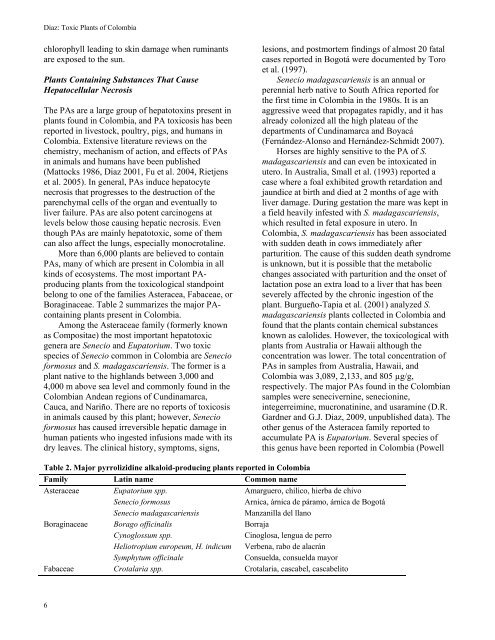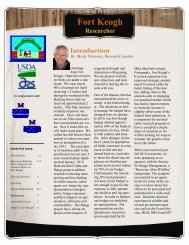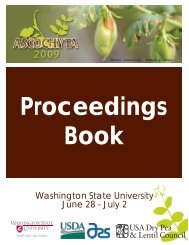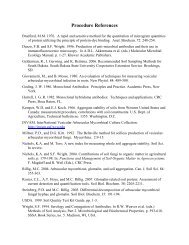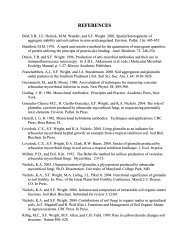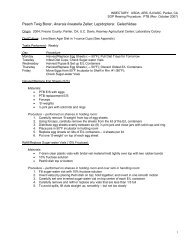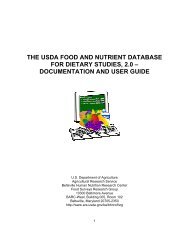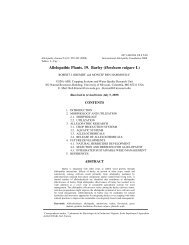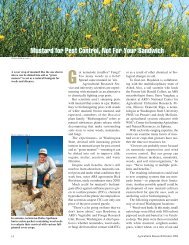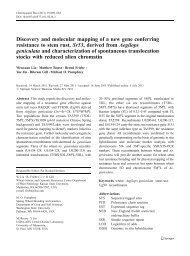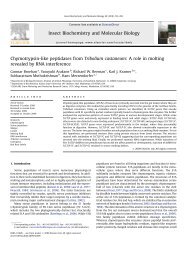International Journal of Poisonous Plant Research - Agricultural ...
International Journal of Poisonous Plant Research - Agricultural ...
International Journal of Poisonous Plant Research - Agricultural ...
Create successful ePaper yourself
Turn your PDF publications into a flip-book with our unique Google optimized e-Paper software.
Diaz: Toxic <strong>Plant</strong>s <strong>of</strong> Colombia<br />
chlorophyll leading to skin damage when ruminants<br />
are exposed to the sun.<br />
<strong>Plant</strong>s Containing Substances That Cause<br />
Hepatocellular Necrosis<br />
The PAs are a large group <strong>of</strong> hepatotoxins present in<br />
plants found in Colombia, and PA toxicosis has been<br />
reported in livestock, poultry, pigs, and humans in<br />
Colombia. Extensive literature reviews on the<br />
chemistry, mechanism <strong>of</strong> action, and effects <strong>of</strong> PAs<br />
in animals and humans have been published<br />
(Mattocks 1986, Diaz 2001, Fu et al. 2004, Rietjens<br />
et al. 2005). In general, PAs induce hepatocyte<br />
necrosis that progresses to the destruction <strong>of</strong> the<br />
parenchymal cells <strong>of</strong> the organ and eventually to<br />
liver failure. PAs are also potent carcinogens at<br />
levels below those causing hepatic necrosis. Even<br />
though PAs are mainly hepatotoxic, some <strong>of</strong> them<br />
can also affect the lungs, especially monocrotaline.<br />
More than 6,000 plants are believed to contain<br />
PAs, many <strong>of</strong> which are present in Colombia in all<br />
kinds <strong>of</strong> ecosystems. The most important PAproducing<br />
plants from the toxicological standpoint<br />
belong to one <strong>of</strong> the families Asteracea, Fabaceae, or<br />
Boraginaceae. Table 2 summarizes the major PAcontaining<br />
plants present in Colombia.<br />
Among the Asteraceae family (formerly known<br />
as Compositae) the most important hepatotoxic<br />
genera are Senecio and Eupatorium. Two toxic<br />
species <strong>of</strong> Senecio common in Colombia are Senecio<br />
formosus and S. madagascariensis. The former is a<br />
plant native to the highlands between 3,000 and<br />
4,000 m above sea level and commonly found in the<br />
Colombian Andean regions <strong>of</strong> Cundinamarca,<br />
Cauca, and Nariño. There are no reports <strong>of</strong> toxicosis<br />
in animals caused by this plant; however, Senecio<br />
formosus has caused irreversible hepatic damage in<br />
human patients who ingested infusions made with its<br />
dry leaves. The clinical history, symptoms, signs,<br />
6<br />
lesions, and postmortem findings <strong>of</strong> almost 20 fatal<br />
cases reported in Bogotá were documented by Toro<br />
et al. (1997).<br />
Senecio madagascariensis is an annual or<br />
perennial herb native to South Africa reported for<br />
the first time in Colombia in the 1980s. It is an<br />
aggressive weed that propagates rapidly, and it has<br />
already colonized all the high plateau <strong>of</strong> the<br />
departments <strong>of</strong> Cundinamarca and Boyacá<br />
(Fernández-Alonso and Hernández-Schmidt 2007).<br />
Horses are highly sensitive to the PA <strong>of</strong> S.<br />
madagascariensis and can even be intoxicated in<br />
utero. In Australia, Small et al. (1993) reported a<br />
case where a foal exhibited growth retardation and<br />
jaundice at birth and died at 2 months <strong>of</strong> age with<br />
liver damage. During gestation the mare was kept in<br />
a field heavily infested with S. madagascariensis,<br />
which resulted in fetal exposure in utero. In<br />
Colombia, S. madagascariensis has been associated<br />
with sudden death in cows immediately after<br />
parturition. The cause <strong>of</strong> this sudden death syndrome<br />
is unknown, but it is possible that the metabolic<br />
changes associated with parturition and the onset <strong>of</strong><br />
lactation pose an extra load to a liver that has been<br />
severely affected by the chronic ingestion <strong>of</strong> the<br />
plant. Burgueño-Tapia et al. (2001) analyzed S.<br />
madagascariensis plants collected in Colombia and<br />
found that the plants contain chemical substances<br />
known as calolides. However, the toxicological with<br />
plants from Australia or Hawaii although the<br />
concentration was lower. The total concentration <strong>of</strong><br />
PAs in samples from Australia, Hawaii, and<br />
Colombia was 3,089, 2,133, and 805 µg/g,<br />
respectively. The major PAs found in the Colombian<br />
samples were senecivernine, senecionine,<br />
integerreimine, mucronatinine, and usaramine (D.R.<br />
Gardner and G.J. Diaz, 2009, unpublished data). The<br />
other genus <strong>of</strong> the Asteracea family reported to<br />
accumulate PA is Eupatorium. Several species <strong>of</strong><br />
this genus have been reported in Colombia (Powell<br />
Table 2. Major pyrrolizidine alkaloid-producing plants reported in Colombia<br />
Family Latin name Common name<br />
Asteraceae Eupatorium spp. Amarguero, chilico, hierba de chivo<br />
Senecio formosus Arnica, árnica de páramo, árnica de Bogotá<br />
Senecio madagascariensis Manzanilla del llano<br />
Boraginaceae Borago <strong>of</strong>ficinalis Borraja<br />
Cynoglossum spp. Cinoglosa, lengua de perro<br />
Heliotropium europeum, H. indicum Verbena, rabo de alacrán<br />
Symphytum <strong>of</strong>ficinale Consuelda, consuelda mayor<br />
Fabaceae Crotalaria spp. Crotalaria, cascabel, cascabelito


